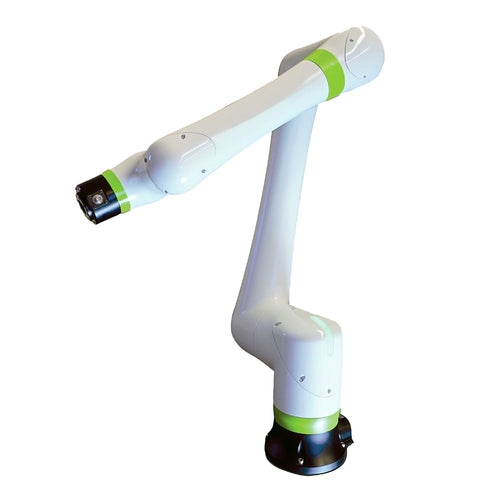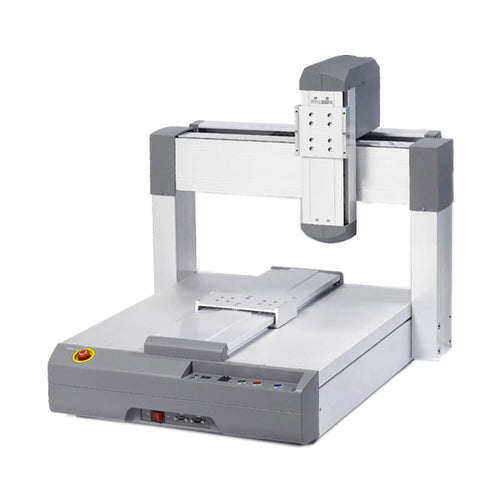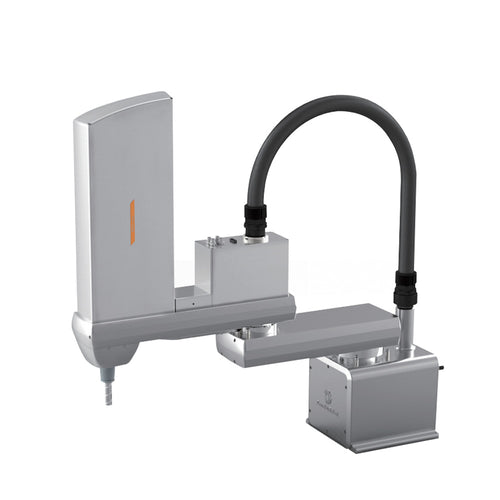We are often asked what the difference is between stepper motors and servo motors. Both are used in robotic fluid and adhesive dispensing systems, but there are some notable distinctions. Each motor type offers different benefits and trade-offs, making it important to understand these differences and how they relate to your application.
At Dispensing.com, our team of experts compares stepper motors versus servo motors, including when to use a servo motor instead of a stepper motor based on your specific application.
Stepper Motors
Stepper motors are open-loop systems that "step" through a series of pulls to create a pre-programmed rotary move. They are ideal for applications where precision control without position feedback is sufficient. In a cartesian robot system, this becomes linear motion typically through a belt drive. Both static motor position and requested motion are determined by the magnetic force of the stator acting on the rotor. You can feel this force by pushing the axis out of position when idle. You can also find robotic arms with stepper motors.
There are three main types of stepper motors:
-
Permanent Magnet (PM): A PM stepper motor uses a permanent magnetized rotor and relatively low step angles. The rotor aligns with the magnetic field generated by the stator circuit. It generally has a high torque (~ force) but lower speed.
-
Variable Reluctance (VR): This type of stepper motor uses a soft iron rotor that aligns with the magnetic field. This setup allows the motor to reach a higher speed, but the torque is usually lower.
-
Hybrid: This setup is a combination of the permanent magnet and variable reluctance types. The rotor has two caps with alternating teeth and is able to reach higher speeds and torque.
Pros
-
Simple Design and Control: While they use a driver, complex calculations or tuning are not required with robots with stepper motors.
-
No Feedback Required: Instead of needing a sensor to detect the motor position, you can simply count the steps.
-
Good Low Speed Torque: Stepper motors offer great torque at lower speeds.
-
Cost-Effective: Compared to other types of motors, stepper motors tend to be lower in cost as well as have a longer lifespan.
Cons
-
Less High-Speed Torque: Stepper motors' torque will decrease as speed increases, and they have a lower torque-to-inertia ratio.
-
Constant Current: Regardless of the requirements, stepper motors always drain maximum current. This can ultimately lead to overheating and decreased efficiency.
-
Unable to Adapt to Load Changes: Unlike closed-loop motor systems, stepper motors struggle to respond to varying load conditions.
-
Issues with Missing a Step: If the load torque is too high, stepper motors may miss a step, which can impact the control. This issue is more common with microstepping.
Servo Motors
Servo motors are closed-loop systems with auto-encoded motors that track real-time position and use this feedback to adjust actual versus desired position. This self-correction provides a high level of accuracy. Consequently, servo motors are commonly found in high-precision automation systems requiring responsive control.
Typically, servo motors drive ball screws to generate linear motion, directly or in a parallel fashion. The feedback available includes position, current draw, torque, and following error range (how far from the desired position). When you try to push an idle servo out of position, you will hear the motor working to hold position, and it will be more difficult to force position loss than with a stepper. Increasing the current frequency will increase the speed at which the motor rotates, and the higher the current, the higher the motor torque.
There are two main types of servo motors.
-
DC Servo Motors: DC or direct current servo motors are controlled by the frequency of electrical input. They are great for applications requiring a high level of precision and accuracy.
-
AC Servo Motors: AC or alternating current motors have multiple control avenues and can respond to changes in input signals. They are known for their high speed, power output, and efficiency and are commonly used in industrial applications.
Pros
-
Good High Speed Torque: Compared to stepper motors, servo motors can achieve a higher torque at higher speeds.
-
Great Precision and Accuracy: Robotic servo motors are known for their high level of accuracy and precision because of their closed-loop control and continuous feedback. They give repeatable, consistent results at various speeds.
-
Consistent with Varying Loads: Servo motors are better for variable load systems as they are able to still maintain their position.
-
Energy Efficient: With lower motor heating and the ability to effectively operate at various speeds, servo motors tend to have better energy efficiency.
Cons
-
More Complex Control: Servo motors for robotic applications require tuning and only work with position feedback.
-
Prone to Hunting: Hunting occurs when the servo motor oscillates around a target position instead of holding steady. This problem can lead to production problems as well as decrease the lifespan of the equipment.
-
Higher Cost: In general, servo motor systems cost more than stepper motor systems, and not every business can afford the upfront costs.
The Differences Between Servo and Stepper Motors
Below is a table showing some basic differences between servo motors and stepper motors. This will also help explain both the capabilities and utility of each type of motor.
| Attribute | Stepper | Servo |
|---|---|---|
| Payload/Holding Force | Generally lower in the same envelope | Generally higher |
| Accuracy | Comparable | Comparable |
| Repeatability | Lower | Higher, due to closed feedback |
|
Velocity + Path Repeatability |
Lower | Higher, with following control of all axes, over wider range of loads and speeds. |
| E-Stop Recovery | Requires homing | Can reset and continue. Strongly preferred for safety device apps. |
| Torque Limits | N/A | Torque can be limited. Has value for safety, PM prediction. |
| Manual Teaching | N/A | Can manually position and save point data, saving time vs. jog |
| Data Availability | N/A - No feedback | Variety of data available. Useful for diagnostics and optimizing the app. |
| Parameter Optimization | A few parameters can be modified | Gain, inertia, other parameters can be optimized to the app. Also some diagnostic value. |
This chart is just a start. We break down the differences between a servo motor and a stepper motor a bit more.
When drawing a path, all axes affect the velocity and position of the tool. Servo axes will give better momentary position, as all axes are within a set tolerance at any moment. Since there is no feedback with steppers, this is not possible. Also, velocity control is better with closed-loop feedback of servos.
Servo motors are much faster for E-Stop recovery/restart. With servo motors, the current position is known, so work can be continued without homing. This is especially useful with long cycle times and palletized work, as the process can be continued with minimal lost time, and the correct pallet restart position can be stored. With steppers, homing causes program interruption, including restarting, removing and re-palletizing of parts, and lost production.
In servo motor systems, torque can be limited for pressing operations as well as to limit force in potential injury scenarios. Setting limits for torque has had some utility in monitoring axis health. As required torque rises, typically an element of the drive is changing state, whether mechanical, motor, or amp.
Note that encoded stepper systems also have position feedback. However, encoded stepper cost is on a par with servo cost, and servo brings other feedback that has utility. So, servo is generally preferred.
Servo or Stepper Motor for Robotic Dispensing: Which Should You Choose?
When choosing between a servo or stepper motor for your dispensing, it is important to ask the following questions:
-
What is the load?
-
What are my torque requirements?
-
What is the speed?
-
Will my load vary?
-
What is the level of precision I need?
-
Do I need torque limiting, manual teaching, or other special capabilities?
-
What is my budget?
While every dispensing setup is different, stepper motor dispensing robots tend to be best for simpler dispensing applications at lower speeds. They can still achieve a high torque at these low speeds and get you repeatable and reliable results. Stepper motor robots may also be less expensive for companies with more limited budgets.
Servo motor robots are ideal for dynamic load applications that require high torque and high speeds, especially in complex or safety-critical dispensing environments. They are designed to provide high precision and accuracy.
Get Started
Looking to incorporate robots into your material dispensing process but not sure where to begin? Let us help. The best option will depend on your specific needs and application. You can talk to one of our experts for personalized guidance about optimizing your dispensing process, integration help, and expected costs.








